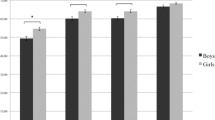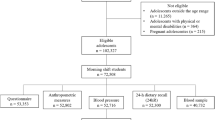Abstract
Background:
There is little information on how breakfast choices are associated with dietary intakes in Australian boys.
Objective:
(i) To determine the proportion of breakfast skippers, ready-to-eat cereal (RTEC) consumers and non-RTEC consumers at breakfast; (ii) to compare breakfast, and daily nutrient intakes and nutrient density, between the three groups; and (iii) to compare daily nutrient intakes against nutrient recommendations.
Subjects/Methods:
Cross-sectional analysis of 12 to 16-year-old boys (n=781) from the 2007 Australian National Children's Nutrition and Physical Activity Survey.
Results:
Forty-two percent of boys consumed RTEC at breakfast; 38% did not consume RTECs; and 20% skipped breakfast. Breakfast skippers had a higher body mass index and waist circumference compared with RTEC consumers (P⩽0.05). At breakfast, RTEC consumers had a higher intake of total sugars and a lower intake of fat and sodium versus non-RTEC consumers. Total daily nutrient density for calcium, iron, thiamin, riboflavin, zinc, dietary folate equivalents, magnesium and iodine was higher for RTEC consumers versus non-RTEC consumers and breakfast skippers (all P⩽0.05). Fifty-nine percent of 14 to 16-year-old RTEC consumers reached the fibre adequate intake versus 34% and 24% of non-RTEC consumers and breakfast skippers, respectively (all P⩽0.01). More RTEC consumers met the calcium estimated average requirements versus non-RTEC consumers and breakfast skippers (P⩽0.01).
Conclusions:
Breakfast choice, specifically RTECs and the foods consumed with them, provide valuable nutrients that may assist boys in meeting nutrient requirements. Consumption of RTECs may be one way in which intakes of key nutrients, relevant for growth and development, could be increased in older boys.
This is a preview of subscription content, access via your institution
Access options
Subscribe to this journal
Receive 12 print issues and online access
$259.00 per year
only $21.58 per issue
Buy this article
- Purchase on Springer Link
- Instant access to full article PDF
Prices may be subject to local taxes which are calculated during checkout


Similar content being viewed by others
References
Albertson AM, Anderson GH, Crockett SJ, Goebel MT . Ready-to-eat cereal consumption: its relationship with BMI and nutrient intake of children aged 4 to 12 years. J Am Diet Assoc 2003; 103, 1613–1619.
Albertson AM, Thompson D, Franko DL, Kleinman RE, Barton BA, Crockett SJ . Consumption of breakfast cereal is associated with positive health outcomes: evidence from the National Heart, Lung, and Blood Institute Growth and Health Study. Nutr Res 2008; 28, 744–752.
Galvin MA, Kiely M, Flynn A . Impact of ready-to-eat breakfast cereal (RTEBC) consumption on adequacy of micronutrient intakes and compliance with dietary recommendations in Irish adults. Public Health Nutr 2003; 6, 351–363.
Song WO, Chun OK, Kerver J, Cho S, Chung CE, Chung SJ . Ready-to-eat breakfast cereal consumption enhances milk and calcium intake in the US population. J Am Diet Assoc 2006; 106, 1783–1789.
Deshmukh-Taskar PR, Nicklas TA, O’Neil CE, Keast DR, Radcliffe JD, Cho S . The relationship of breakfast skipping and type of breakfast consumption with nutrient intake and weight status in children and adolescents: the National Health and Nutrition Examination Survey 1999–2006. J Am Diet Assoc 2010; 110, 869–878.
Cho S, Dietrich M, Brown CJ, Clark CA, Block G . The effect of breakfast type on total daily energy intake and body mass index: results from the Third National Health and Nutrition Examination Survey (NHANES III). J Am Coll Nutr 2003; 22, 296–302.
Alexy U, Wicher M, Kersting M . Breakfast trends in children and adolescents: frequency and quality. Public Health Nutr 2010; 13, 1795–1802.
Bruening M, Larson N, Story M, Neumark-Sztainer D, Hannan P . Predictors of adolescent breakfast consumption: longitudinal findings from project EAT. J Nutr Educ Behav 2011; 43, 390–395.
Keski-Rahkonen A, Kaprio J, Rissanen A, Virkkunen M, Rose RJ . Breakfast skipping and health-compromising behaviors in adolescents and adults. Eur J Clin Nutr 2003; 57, 842–853.
Smith KJ, Gall SL, McNaughton SA, Blizzard L, Dwyer T, Venn AJ . Skipping breakfast: longitudinal associations with cardiometabolic risk factors in the Childhood Determinants of Adult Health Study. Am J Clin Nutr 2010; 92, 1316–1325.
Franko DL, Albertson AM, Thompson DR, Barton BA . Cereal consumption and indicators of cardiovascular risk in adolescent girls. Public Health Nutr 2011; 14, 584–590.
Barton BA, Eldridge AL, Thompson D, Affenito SG, Striegel-Moore RH, Franko DL et al. The relationship of breakfast and cereal consumption to nutrient intake and body mass index: the National Heart, Lung, and Blood Institute Growth and Health Study. J Am Diet Assoc 2005; 105, 1383–1389.
Preziosi P, Galan P, Deheeger M, Yacoub N, Drewnowski A, Hercberg S . Breakfast type, daily nutrient intakes and vitamin and mineral status of French children, adolescents, and adults. J Am Coll Nutr 1999; 18, 171–178.
Utter J, Scragg R, Mhurchu CN, Schaaf D . At-home breakfast consumption among New Zealand children: associations with body mass index and related nutrition behaviors. J Am Diet Assoc 2007; 107, 570–576.
Albertson AM, Affenito SG, Bauserman R, Holschuh NM, Eldridge AL, Barton BA . The relationship of ready-to-eat cereal consumption to nutrient intake, blood lipids, and body mass index of children as they age through adolescence. J Am Diet Assoc 2009; 109, 1557–1565.
Kosti RI, Panagiotakos DB, Zampelas A, Mihas C, Alevizos A, Leonard C et al. The association between consumption of breakfast cereals and BMI in schoolchildren aged 12–17 years: the VYRONAS study. Public Health Nutr 2008; 11, 1015–1021.
Panagiotakos DB, Antonogeorgos G, Papadimitriou A, Anthracopoulos MB, Papadopoulos M, Konstantinidou M et al. Breakfast cereal is associated with a lower prevalence of obesity among 10–12-year-old children: the PANACEA study. Nutr Metab Cardiovasc Dis 2008; 18, 606–612.
Boutelle K, Neumark-Sztainer D, Story M, Resnick M . Weight control behaviors among obese, overweight, and nonoverweight adolescents. J Pediatr Psychol 2002; 27, 531–540.
Ortega RM, Requejo AM, Lopez-Sobaler AM, Quintas ME, Andres P, Redondo MR et al. Difference in the breakfast habits of overweight/obese and normal weight schoolchildren. Int J Vitam Nutr Res 1998; 68, 125–132.
Wolfe WS, Campbell CC, Frongillo Jr EA, Haas JD, Melnik TA . Overweight schoolchildren in New York State: prevalence and characteristics. Am J Public Health 1994; 84, 807–813.
Pearson N, MacFarlane A, Crawford D, Biddle SJ . Family circumstance and adolescent dietary behaviours. Appetite 2009; 52, 668–674.
Shaw ME . Adolescent breakfast skipping: an Australian study. Adolescence 1998; 33, 851–861.
Affenito SG, Thompson DR, Barton BA, Franko DL, Daniels SR, Obarzanek E et al. Breakfast consumption by African-American and white adolescent girls correlates positively with calcium and fiber intake and negatively with body mass index. J Am Diet Assoc 2005; 105, 938–945.
Albertson AM, Franko DL, Thompson D, Eldridge AL, Holschuh N, Affenito SG et al. Longitudinal patterns of breakfast eating in Black and White adolescent girls. Obesity (Silver Spring) 2007; 15, 2282–2292.
Department of Health and Ageing. 2007 Australian National Children's Nutrition and Physical Activity Survey: Main Findings Report/Prepared by the Commonwealth Scientific Industrial Research Organisation (CSIRO), Preventative Health National Research Flagship, and the University of South Australia. ACT: Canberra, 2007. Available at: http://www.health.gov.au/internet/main/publishing.nsf/Content/66596E8FC68FD1A3CA2574D50027DB86/$File/childrens-nut-phys-survey.pdf. Accessed 14 June 2011, 2007.
Magarey A, Boulton J . The Adelaide Nutrition Study. 2. Macronutrient and micronutrient intakes at ages 11, 13 and 15 years: age and sex differences. Aust J Nutr Diet 1994; 51, 111–119.
Robson PJ, Gallagher AM, Livingstone MB, Cran GW, Strain JJ, Savage JM et al. Tracking of nutrient intakes in adolescence: the experiences of the Young Hearts Project, Northern Ireland. Br J Nutr 2000; 84, 541–548.
National Health and Medical Research Council. Nutrient Reference Values for Australia and New Zealand. Department of Health and Ageing. Available at: http://www.nhmrc.gov.au/_files_nhmrc/file/publications/synopses/n35.pdf. Accessed 19 June 2011.
Magarey AM, Daniels LA, Boulton TJ . Prevalence of overweight and obesity in Australian children and adolescents: reassessment of 1985 and 1995 data against new standard international definitions. Med J Aust 2001; 174, 561–564.
Williams P . Breakfast and the diets of Australian children and adolescents: an analysis of data from the 1995 National Nutrition Survey. Int J Food Sci Nutr 2007; 58, 201–216.
Grieger JA, Scott J, Cobiac L . Dietary patterns and breast-feeding in Australian children. Public Health Nutr 2011; 14, 1939–1947.
Williams PG . What Australians eat for breakfast: an analysis of data from the 1995 National Nutrition Survey. Nutr Diet 2002; 59, 103–112.
O’Dea J, Abraham S, Heard R . Food habits, body image and weight control practices of young male and female adolescents. Aust J Nutr Diet 1996; 53, 32–38.
Gibson SA, O’Sullivan KR . Breakfast cereal consumption patterns and nutrient intakes of British schoolchildren. J R Soc Health 1995; 115, 366–370.
Szajewska H, Ruszczynski M . Systematic review demonstrating that breakfast consumption influences body weight outcomes in children and adolescents in Europe. Crit Rev Food Sci Nutr 2010; 50, 113–119.
de Castro JM . When, how much and what foods are eaten are related to total daily food intake. Br J Nutr 2009; 102, 1228–1237.
Berteus Forslund H, Lindroos AK, Sjostrom L, Lissner L . Meal patterns and obesity in Swedish women—a simple instrument describing usual meal types, frequency and temporal distribution. Eur J Clin Nutr 2002; 56, 740–747.
Thompson OM, Ballew C, Resnicow K, Gillespie C, Must A, Bandini LG et al. Dietary pattern as a predictor of change in BMI z-score among girls. Int J Obes (Lond) 2006; 30, 176–182.
Gibson S . Trends in energy and sugar intakes and body mass index between 1983 and 1997 among children in Great Britain. J Hum Nutr Diet 2010; 23, 371–381.
Albertson AM, Thompson DR, Franko DL, Holschuh NM . Weight indicators and nutrient intake in children and adolescents do not vary by sugar content in ready-to-eat cereal: results from National Health and Nutrition Examination Survey 2001–2006. Nutr Res 2011; 31, 229–236.
Rangan A, Flood VM, Gill TP . Misreporting of energy intake in the 2007 Australian Children's Survey: identification, characteristics and impact of misreporters. Nutrients 2011; 3, 186–199.
Acknowledgements
This work was funded by Kellogg Australia. M Celander from Kellogg Australia assisted with devising the overall aims of the analyses and reading the final drafts of the manuscript.
Author information
Authors and Affiliations
Corresponding author
Ethics declarations
Competing interests
The authors declare no conflict of interest.
Rights and permissions
About this article
Cite this article
Grieger, J., Cobiac, L. Comparison of dietary intakes according to breakfast choice in Australian boys. Eur J Clin Nutr 66, 667–672 (2012). https://doi.org/10.1038/ejcn.2011.220
Received:
Revised:
Accepted:
Published:
Issue Date:
DOI: https://doi.org/10.1038/ejcn.2011.220
Keywords
This article is cited by
-
Ready-to-eat cereals improve nutrient, milk and fruit intake at breakfast in European adolescents
European Journal of Nutrition (2016)
-
Performance of a five category front-of-pack labelling system – the 5-colour nutrition label – to differentiate nutritional quality of breakfast cereals in France
BMC Public Health (2015)
-
European adolescent ready-to-eat-cereal (RTEC) consumers have a healthier dietary intake and body composition compared with non-RTEC consumers
European Journal of Nutrition (2015)



